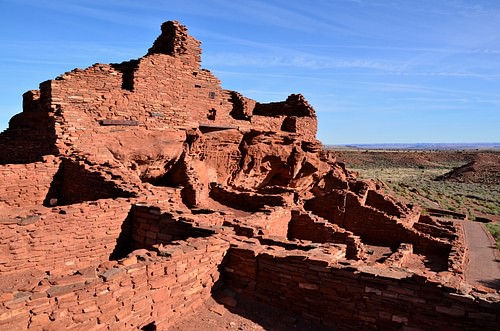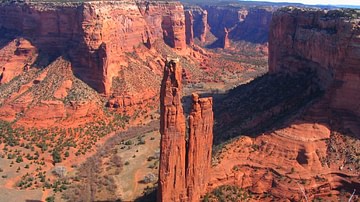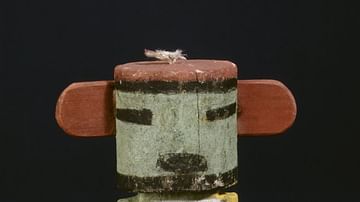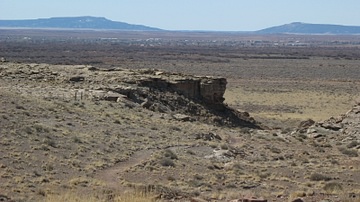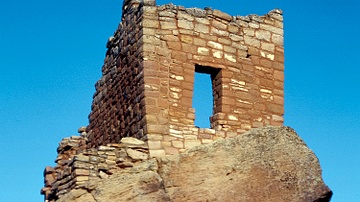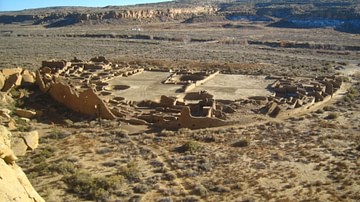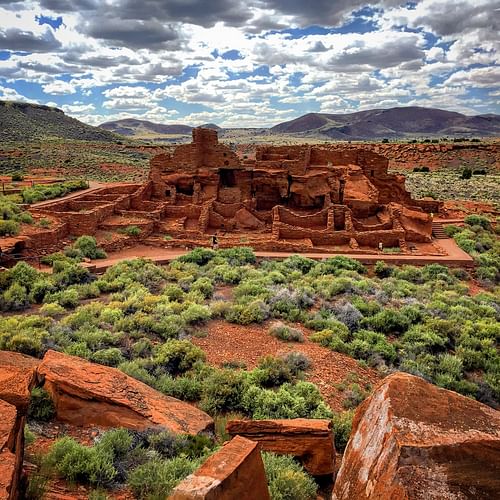
Wupatki or Wupatki National Monument is an Ancestral Puebloan site that contains over 800 ancient ruins. It is situated in the north-central region of the US state of Arizona and is approximately 50 km (31 miles) northeast of the present-day city of Flagstaff, 282 km (175 miles) north of Phoenix, and 16 km (10 miles) northeast of Sunset Crater Volcano National Monument. Wupatki Pueblo, the largest structure within the National Monument, was once the home of roughly 85-150 people who additionally built two kiva structures, a ballcourt, and other buildings, all of which were constructed between 1100-1200 CE. Wupatki Pueblo reflects a confluence of artistic and architectural styles; the area was the site of intense cross-cultural interaction among different Native American cultures. Indigenous peoples abandoned Wupatki Pueblo and its nearby hamlets c. 1275 CE under mysterious circumstances. US Lieutenant Lorenzo Sitgreaves rediscovered and documented Wupatki Pueblo and other ruins in 1851 CE as he searched for a suitable overland route from New Mexico to California. Wupatki is currently a US National Monument, and the US National Park Service has overseen the site's ruins since it was first registered in 1924 CE by the US President Calvin Coolidge.
Geography & Prehistory
The name "Wupatki" is of Hopi derivation and means "tall house," which refers to the ruined pueblos formerly occupied in ancient times. The Wupatki National Park rests altogether on an area of 35,422 acres or 56 square miles. Wupatki is located on the extreme southern part of the Colorado Plateau in what at first appears to be an inhabitable terrain. Nonetheless, there is much diversity in unique ecological zones and microclimates because Wupatki occupies a climate zone between the Painted Desert and the more fertile highlands of Northern Arizona. Ponderosa pines, juniper, and pinyon pine, and grasslands thus flourish in the upper elevations while sagebrush, yucca, and other plants occupy lower terrains.
This ecological and environmental diversity permitted peoples to settle the area in and around Wupatki in prehistoric times. Archaeology confirms that humans have inhabited the region around Wupatki for nearly 10,000 years. Two spear points dating to 8,000-11,000 years ago have been found in the area. Recent research also suggests that prehistoric Clovis hunters might have pursued either mammoth or bison in the Wupatki area. Nomadic tribes of Native Americans frequented the region until about c. 500 CE to hunt wild antelope and jackrabbits, while also gathering food on a seasonal basis.
Ancestral Puebloan Occupation
The Sunset Crater Volcano erupted c. 1064-1065 CE, forever altering life in the ancient desert Southwest. Volcanic ash and cinders spread over a space of 1280 km (800 miles) around the volcano, and it was certainly noticed by the ancient Hohokam people living in what is now present-day southern Arizona as well as Ancestral Puebloan peoples based in Chaco Canyon. The region around the volcano, including Wupatki, soon emerged as something akin to a cultural melting pot. Scientists and archaeologists have suggested that volcanic activity created an ultra fertile soil, which helped conserve moisture, allowing crops like corn and cotton grow more efficiently.
Between 1100 and 1160 CE, it has been estimated that perhaps 3,000 people relocated to the area in and around Wupatki National Monument to occupy new hamlets and farm. A petroglyph located some 10 km (6 miles) northeast of Wupatki depicts the falling volcanic dust and possibly a migration of peoples to and from the region. Mesa Verde National Park in what is now Colorado is one of the few places that can rival Wupatki in the density of ruin sites. It averages around more than 40 sites per square mile, but in certain portions of Wupatki National Monument, it is more than 100 sites per square mile.
The local indigenous population in the area at the time of Sunset Crater's 11th-century CE eruption consisted primarily of Sinagua people who employed advanced masonry styles that were similar to the Mogollon culture of what is now southern New Mexico and Arizona. In the decades following the eruption, it appears that some Sinagua people migrated elsewhere and the remaining Sinagua population was joined by Ancestral Puebloan (Anasazi) people like the Winslow and Kayenta of eastern and northern Arizona. The Cohonina from what is present-day western Arizona also seem to have moved into the region, and some Hohokam people from southern Arizona made their way to the region as well.
These people all mingled with the indigenous Sinagua, sharing new ideas concerning technologies, art, and agriculture, while erecting structures that generally conform to and resemble those of other Ancestral Puebloan Great Houses like those of Aztec ruins in New Mexico and others that lie elsewhere in the Four Corners region between New Mexico, Colorado, Arizona, and Utah. Wupatki is nonetheless 300 km away from Chaco Canyon in what is present-day New Mexico, and it should be remembered that Wupatki was more contemporaneous with Aztec Ruins rather than the ruins at Chaco Canyon. The buildings at Wupatki National Monument were made from red Moenkopi sandstone, basalt, and Kaibab limestone. Wupatki Pueblo is the largest ruined pueblo within the boundaries of the park, and it contains over 100 rooms. There are other accessible pueblos nearby, including the Citadel, Lomaki, Nalakihu, Wukoki, and the Box Canyon Ruins. The Citadel was the next largest after Wupatki Pueblo with more than 50 rooms. The majority of sites at Wupatki, however, are small in size; 1,080 out of 2,397 sites contain a single room, while 723 have two to six rooms or pithouses. At many of these sites, one finds the distinctive T-shaped doorways that attests to strong Ancestral Puebloan architectural influence.
The people who inhabited Wupatki built stone houses perched atop the shallow canyons that led to the Little Colorado River, and they traded with their neighbors near and far. Archaeologists have uncovered 41 scarlet macaw remains - used in religious ceremonies - in addition to turquoise, many copper bells, and shells from the Pacific Ocean. At Wupatki, one also finds both open kivas that were unroofed and common amongst the Ancestral Puebloan people as well as a ceremonial ballcourt like those used by the Hohokam. This particular ballcourt is the most northerly ballcourt in the ancient Southwest. All of these structures date from c. 1125-1195 CE, and they attest to the rich confluence of ideas in Wupatki's ceremonial landscape.
Abandonment & Native Memory
Wupatki's abandonment mirrors that of other ancient sites in the desert Southwest including Hovenweep in Utah and the Ancestral Puebloan settlements at Mesa Verde National Park. Some have theorized that the soil around Wupatki became exhausted due to intensive agricultural production. A few have suggested that the volcanic cinders and ash which had made the region so fertile were blown away by winds, leaving little land available for agricultural cultivation. Still others pointed out that the region experienced a prolonged period of drought in the 13th century CE. It would seem likely that Wupatki's inhabitants abandoned their pueblos, pithouses, and hamlets gradually, and they migrated towards the west or south to form other pueblos.
After c. 1300 CE, it is known that the Hopi tribe performed ceremonies and hunted in and around Wupatki. Many ruins at Wupatki are well-preserved because they are still revered by Native Americans. 13 different indigenous Native American communities claim ties of blood or history to Wupatki at the present: the Hopi Tribe of Arizona, the Navajo Nation, the Zuni Tribe of the Zuni Reservation, the Havasupai Tribe, the Hualapai Tribe, the Fort McDowell Yavapai Nation, the Yavapai-Prescott Indian Tribe, the Yavapai-Apache Nation, the White Mountain Apache Tribe, the Tonto Apache Tribe of Arizona, the San Carlos Apache Tribe of Arizona, the Kaibab Band of Paiutes, and the San Juan Southern Paiute Tribe of Arizona. Wupatki's ruins remain of immense importance to the Hopi and Zuni peoples who continue to revere it as a sacred place and tell stories about its past through oral histories. Although the Navajo later settled the areas in and around Wupatki c. 1750-1800 CE, certain Navajo clans claim affinity to Wupatki's ruins too, as the ruins aid the Navajo in preserving their records of clan migrations in the region as evidenced by oral tradition.

